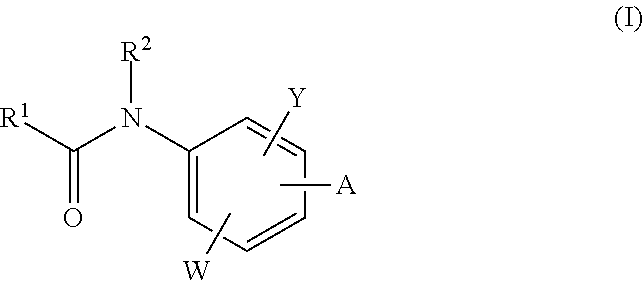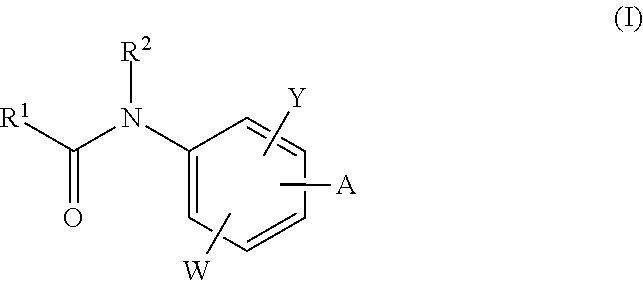Neurotrypsin inhibitors
a technology of neutropenia and inhibitors, applied in the field of acylaminophthalic acid amides, can solve the problems of fear and withdrawal, schizophrenia sufferers often suffering terrifying symptoms, speech and behavior can be so disorganized,
- Summary
- Abstract
- Description
- Claims
- Application Information
AI Technical Summary
Benefits of technology
Problems solved by technology
Method used
Image
Examples
example 1
2-(3-Chlorobenzo[b]thiophene-2-carboxamido)-4-(4-chlorophenylcarbamoyl)-benzoic acid
Method 1
[0155]
[0156]To a solution of 2-nitroterephthalic acid 1-methyl ester (1 eq.) in toluene was added thionyl chloride (2.5 eq.) and a catalytic amount of pyridine, and the mixture was refluxed for 4 h. The reaction mixture was concentrated to half of its original volume. Some more volume of toluene was added to the reaction mixture, and the pH of the solution was made neutral. A toluene solution of p-chloroaniline (1.6 eq.) was added and the solution stirred for 12-14 h at room temperature. The reaction mixture was concentrated and dissolved in ethyl acetate. The ethyl acetate solution was washed with dil. HCl and washed with water twice. The dried ethyl acetate solution was concentrated and chromatographed over silica gel. Eluting with 12-15% ethyl acetate-hexane afforded 75-80% of the desired product. This was dissolved in MeOH and hydrogenated for 18-20 h in the presence of 10% platinum sulfi...
example 52
2-(3-Chlorobenzo[b]thiophene-2-carboxamido)-4-(thiazol-2-ylcarbamoyl)-benzoic acid
Method 2
[0160]
[0161]2-Aminoterephthalic acid 1-methyl ester was dissolved in THF, and 1.1 eq. of 3-chloro-benzo[b]thiophene-2-carbonyl chloride was added. The reaction mixture was refluxed for 14 h, then cooled at room temperature and concentrated under vacuum. The crude residue was triturated with diethyl ether, dissolved in DMF, and 2-aminothiazole (1.2 eq.), EDCl (1.5 eq.), HOBt (0.5 eq.) and DIEA (2.5 eq.) were added at 5-10° C. The reaction mixture was stirred at room temperature for 16 h, then diluted with water. The precipitated solid was collected by suction filtration and dried, to provide 70% methyl 2-(3-chloro-benzo[b]thiophene-2-carboxamido)-4-(thiazol-2-ylcarbamoyl)benzoate. This product was dissolved in THF-water (3:1) and treated with LiOH (1.1 eq.). The solution was stirred overnight at room temperature, concentrated under vacuum, and the residue dissolved in the minimum volume of water...
example 141
2-(4-(5,6-Dichloro-1H-benzo[d]imidazol-2-yl)benzamido)-5-(4-(4-fluorobenzyl)piperidine-1-carbonyl)benzoic acid
Method 3
[0164]
[0165]In a 1 L round-bottomed flask, to a mix of periodic acid (41.9 g, 184 mmol) and methyl 5-methyl-2-nitrobenzoate (8.97 g, 46.0 mmol) in 500 ml of acetonitrile, CrO3 (0.919 g, 9.19 mmol) was added portionwise and the mix was stirred overnight at RT. About 200 ml of isopropanol were cautiously added to destroy CrO3 and the mix was stirred for 2 h at RT; the inorganic solids were eliminated by filtration, then the solvent was evaporated under vacuum. The residue was partitioned between diluted HCl and AcOEt; the organic phase was further washed with brine, dried on Na2SO4 and evaporated; the resulting solid was washed with DCM to afford 7.68 g of crude 3-methoxycarbonyl-4-nitrobenzoic acid (74.2% yield) as a white solid.
[0166]To a suspension of this compound (0.6 g, 2.66 mmol) in dry DCM (50 ml), oxalyl dichloride (0.338 ml, 4.00 mmol) was added in one portio...
PUM
| Property | Measurement | Unit |
|---|---|---|
| temperature | aaaaa | aaaaa |
| pH | aaaaa | aaaaa |
| temperature | aaaaa | aaaaa |
Abstract
Description
Claims
Application Information
 Login to View More
Login to View More - R&D
- Intellectual Property
- Life Sciences
- Materials
- Tech Scout
- Unparalleled Data Quality
- Higher Quality Content
- 60% Fewer Hallucinations
Browse by: Latest US Patents, China's latest patents, Technical Efficacy Thesaurus, Application Domain, Technology Topic, Popular Technical Reports.
© 2025 PatSnap. All rights reserved.Legal|Privacy policy|Modern Slavery Act Transparency Statement|Sitemap|About US| Contact US: help@patsnap.com



